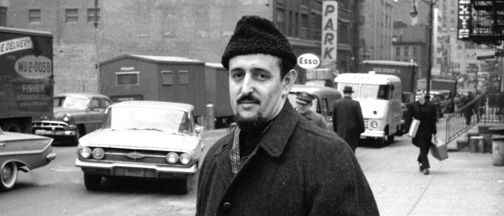continued . . .
My father's photographs covered everything from the outlandishly exotic to the routinely mundane. One day he received a call from representatives of Savador Dali, who had just finished painting his bathtub. Dali was afraid the hotel staff would wash it away before it could be immortalized, and so he wanted a photograph to preserve it. Some of his favorite images were the Marboro bookstore on 8th Street, a motorist getting a ticket for driving in Washington Square park (until 1958 traffic was allowed in the park), Balducci's in its original location on Greenwich Avenue and a man in kilt in Washington Square park. The dual prisms of time and legend add much depth and context to even as simple an image as people browsing in a bookstore.
Because he was a commercial photographer by day, shooting weddings, advertising images and so forth—the photography my father did on his own time became the outlet for his unfettered creativity and singular sense of perception. He was a sensitive, talented and highly creative person who just never caught a break as a pursuer of art.
Robert Otter was born in February 1926 and like my mother Jeanne, grew up in the Bronx. At nine years old he developed asthma, which ultimately kept him out of military service during World War II. While that would have been a positive thing from a 1960s Village viewpoint, the mindset in the '40s was quite the opposite. So he studied radio technology in the hopes it would get him into the Merchant Marine despite his medical condition, but was also denied because of his asthma.
After attending Bronx High School of Science and City College of New York, he graduated from Parsons School of Design in 1948, immediately joining New York's Hirshon Garfield Advertising firm, where he served as Art Director until 1956. Following that, he was Executive Art Director at two more prominent advertising firms, deGarmo, Inc. and Doner and Peck until 1962, when he embarked on his career as a freelance photographer.
Around 1970 he tried to patent a "photo cube," where each facet depicted a different perspective of the subject, but he found that there were too many other patents of a similar nature. After twelve years of struggling to handle the pressures of supporting a family while dealing with the overhead of maintaining a photographic studio, he went into the real estate business. In giving us the security, comfort and basic necessities we all needed, he made the artist's ultimate sacrifice, the abandonment of his Art, and he never photographed professionally again.
In 1972, we were burned out of our Riverside Drive apartment, but fortunately his studio still existed and all his negatives were there at the time. The greatest desire of all artists is to share their art. Now, some fifty years after he began life as a photographer, I offer my father's contribution for the world to view. —Ned Otter

